Limiting reactant - Study guides, Class notes & Summaries
Looking for the best study guides, study notes and summaries about Limiting reactant? On this page you'll find 274 study documents about Limiting reactant.
Page 2 out of 274 results
Sort by
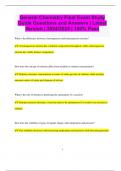
-
General Chemistry Final Exam Study Guide Questions and Answers | Latest Version | 2024/2025 | 100% Pass
- Exam (elaborations) • 17 pages • 2024
- Available in package deal
-
- $9.71
- + learn more
General Chemistry Final Exam Study Guide Questions and Answers | Latest Version | 2024/2025 | 100% Pass What is the difference between a homogeneous and heterogeneous mixture? A homogeneous mixture has a uniform composition throughout, while a heterogeneous mixture has visibly distinct components. How does the concept of molarity differ from molality in solution concentration? Molarity measures concentration as moles of solute per liter of solution, while molality measures moles of...

-
Chem 162 Final Exam Questions and Answers Latest Updated 2024/2025 (Graded A+)
- Exam (elaborations) • 53 pages • 2024
- Available in package deal
-
- $16.49
- + learn more
Chem 162 Final Exam Questions and Answers Latest Updated 2024/2025 (Graded A+) Chemistry definition correct answers Study of structure, properties, transformations of matter Matter correct answers Anything that has mass + takes up space Phases: solid, liquid, gas Condensed phases = solids + liquids Intermolecular Forces (IMF) correct answers = Interactions between molecules/atoms/ions Solution correct answers = Homogenous mixtures of 2+ pure substances In a solution, the solute is disperse...
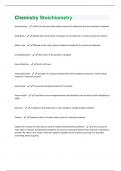
-
Chemistry Stoichiometry Questions And Answers Graded A+
- Exam (elaborations) • 2 pages • 2024
- Available in package deal
-
- $7.99
- + learn more
Stoichiometry - Part of chemistry that studies amount of substances that are involved in reactions Mole Ratio - Identify how many moles of product are formed from a certain amount of reactant. Molar mass - Defined as the mass of given substance divided by its amount of substance Limiting Reaction - How much of the product is produce Excess Reaction - what is left over Theoretical yield - Quantify of a product obtained from the complete conversion of the limiting reactant in chemical reacti...
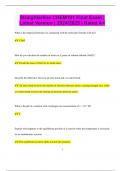
-
Straighterline CHEM101 Final Exam | Latest Version | 2024/2025 | Rated A+
- Exam (elaborations) • 52 pages • 2024
-
- $11.65
- + learn more
Straighterline CHEM101 Final Exam | Latest Version | 2024/2025 | Rated A+ What is the empirical formula of a compound with the molecular formula C6H12O6? CH2O How do you calculate the number of moles in 5 grams of sodium chloride (NaCl)? Divide the mass of NaCl by its molar mass. Describe the difference between an ionic bond and a covalent bond. An ionic bond involves the transfer of electrons between atoms, creating charged ions, while a covalent bond involves the sharing of ...
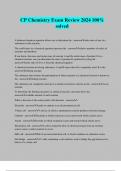
-
CP Chemistry Exam Review 2024 100% solved
- Exam (elaborations) • 16 pages • 2024
-
- $12.49
- + learn more
CP Chemistry Exam Review 2024 100% solved A balanced chemical equation allows one to determine the - answermole ratio of any two substances in the reaction. The coefficients in a chemical equation represent the - answerrelative numbers of moles of reactants and products. If one knows the mass and molar mass of reactant A and the molar mass of product D in a chemical reaction, one can determine the mass of product D produced by using the - answermole ratio of D to A from the chemical equa...

-
CP Chemistry Exam Review 2024 100% solved
- Exam (elaborations) • 16 pages • 2024
-
- $12.49
- + learn more
CP Chemistry Exam Review 2024 100% solved A balanced chemical equation allows one to determine the - answermole ratio of any two substances in the reaction. The coefficients in a chemical equation represent the - answerrelative numbers of moles of reactants and products. If one knows the mass and molar mass of reactant A and the molar mass of product D in a chemical reaction, one can determine the mass of product D produced by using the - answermole ratio of D to A from the chemical equa...
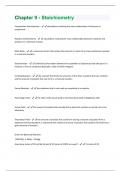
-
Chapter 9 - Stoichiometry Questions And Answers With Latest Updates
- Exam (elaborations) • 2 pages • 2024
- Available in package deal
-
- $7.99
- + learn more
Composition Stoichiometry - calculations involving the mass relationships of elements in compounds Reaction Stoichiometry - calculations involving the mass relationships between reactants and products in a chemical reaction Mole Ratio - a conversion factor that relates the amounts in moles of any two substances involved in a chemical reaction Stoichiometry - (chemistry) the relation between the quantities of substances that take part in a reaction or form a compound (typically a ratio of ...
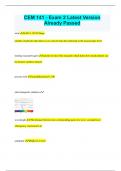
-
CEM 141 - Exam 2 Latest Version Already Passed
- Exam (elaborations) • 14 pages • 2024
- Available in package deal
-
- $9.99
- + learn more
CEM 141 - Exam 2 Latest Version Already Passed mole 6.022 x 10^23 things number of particles that allows us to convert from the molecular to the macroscopic level limiting reactant/reagent amount of one of the reactants which limits how much product can be formed. smallest amount. percent yield actual/theoretical x 100 electromagnetic radiation wavelength The distance between two corresponding parts of a wave. seconds/wave. 1/frequency. measured in m amplitude Height of ...

-
Test Bank For Chemistry 10th Edition International Edition by Kenneth W
- Exam (elaborations) • 955 pages • 2023
-
- $31.75
- + learn more
Chapter 3—Chemical Equations and Reaction Stoichiometry MULTIPLE CHOICE 1. Which of the following is not a consequence of the Law of Conservation of Matter? a. It provides a basis for balancing chemical equations. b. It means that there will be no observable change in the quantity of matter during a chemical reaction. c. As a result, there will be the same number of moles on both the reactant and the product side of a balanced equation. d. It can be stated as "matter is neither creat...
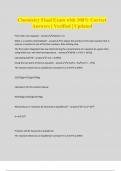
-
Chemistry Final Exam with 100% Correct Answers | Verified | Updated
- Exam (elaborations) • 17 pages • 2024
- Available in package deal
-
- $12.49
- + learn more
Chemistry Final Exam with 100% Correct Answers | Verified | Updated First order rate equation - answerln(Ao/A) = kt What is a reaction intermediate? - answerIt's always the product in the slow reaction that is used as a reactant in one of the fast reactions. Rate limiting step. The first order integrated rate law: Determining the concentration of a reactant at a given time using initial conc and rate by temperature. - answerln[A]t = e^(-kt + ln[A]₀) Calculating half-life - answert 1/2 ...

Study stress? For sellers on Stuvia, these are actually golden times. KA-CHING! Earn from your study resources too and start uploading now. Discover all about earning on Stuvia


